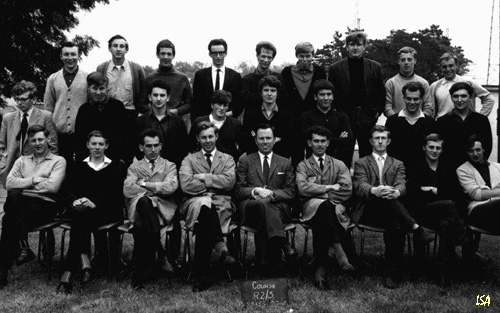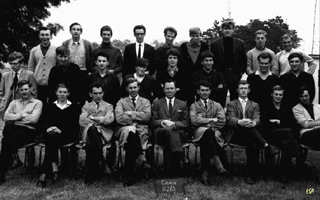 |
Bruce Lloyd attended course R 2/3 from 17.5.1965 to 9.7.1965 and course R 1/8 from 20.7.1964 to 18.8.1964. |
Bruce Lloyd, an apprentice at Bletchley during 1965 recalls...
I did the Youth in Training courses and I mainly remember the telephonists or telegraph operators being trained there - I was seventeen and my main interest was girls either at the dances and social functions in the main house or in the neighbouring towns.
The forest of telephone poles (see picture top of page) were only about 8 feet tall as I recall; nearby was a similar forest of similarly short poles where we practised our skill at recognising decayed and unsafe poles.
We put in hours practising wiring up the various combinations of 706 type phones and extensions. Also tested our patience running wires up and down walls and along skirting boards hammering in staples the regulation distances apart. Used waxed string to create elegant wiring looms, adjusted dozens of 3000 type relays for correct twining, tension etc. We sorted, arranged and twisted together hundreds of pairs of paper coated lead sheathed wires and created beautiful lead joints using plumbers black and ladles of molten lead (that was my favourite task). Learned the mantra of blue, orange, green, brown, slate... Learned the purpose of A, B, C etc. relays in Strowger pre-2000 selectors.
I remember my time at Bletchley as being very enjoyable, for many of us it was our first time away from home - or at least the first not constantly supervised by teachers day and night as on school trips.
 |
Trainee Technician Apprentice B, course R2/3 17th May to 9th July 1965. With thanks to Bruce Lloyd. |
In the well-ordered Post Office, all stores (forms, equipment and sundries) had either an item number or identifying code.
 |
Here are the A2049 forms for the courses Youth A and TTA B. |
The standard (modern) telephone was the 706 with a plastic case which came in 7 colours, and several versions:
|
|
Cable Jointing
The paper insulated lead cables were in layers and each layer had a green tracer, then the pairs in that layer had one to four red stripes repeated in order. It was very important to tie off the layers when you opened out the cable, very easy to lose the order or forget which way the cable was round (and did you curse the cable gang who pulled a cable in the wrong way round so the layers went in opposite directions and you ended up with a real birds nest!) We also had the beginnings of plastic coated cables, joined the wire the same way as paper coated i.e. twisted together but with plastic sleeves rather than paper and the cables went into a plastic tube with a rubber plug between two brass plates which squashed the rubber to seal it all up, I think they still pressurised the plastic cables from the exchange, but there was talk of abandoning that in years to come. The lead cables had to be pressurised because as soon as water touched the paper the cable was useless.
Exchange Work
I worked in Folkestone exchange, a Non-Director exchange with a mixture of Pre-2000 and 2000 types, it had several satellite exchanges. When I arrived so did STD and I spent many tedious hours soldering grading for GRACIE. As an apprentice (until they offered me a job in transmission) my aim in life was to get my own satellite exchange area job, mixture of exchange, subs and line maintenance between Hythe and Romney Marsh. [GRACIE-nickname for Group Routing And Charging Equipment.]
With thanks to Bruce Lloyd.
All logos and trade marks are the property of their respective owners and are used on the Light Straw site(s) for review only. Students and researchers are recommended to make their own independent enquiries as to the accuracy of the information contained therein.